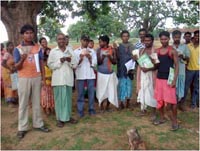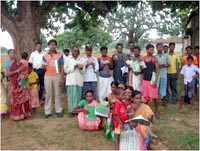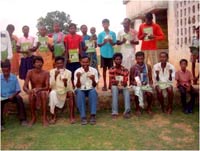Jamtara is one of the disadvantage district of Jharkhand state in India. The district is also blessed with forest of Butea monosperma, commonly called the ‘flame of forest’. Agriculture is the major source of income for this rainfed area. Normally palas trees were being utilized for fuel wood and other basic requirements of village. Many farmers cut these trees as these are of no economic value. A livelihood project of NAIP was envisaged for creating awareness to tap livelihood from available natural resources. The villagers of Baramajhadih village of Narayanpur block; Dahartola, Charedih, Rupaidih, Sarumundu and Sinjotola of Jamtara block have successfully produce and marketed broodlac from their palas tree within one year of its introduction as a part of intervention by NAIP, ICAR. Ten farmers of village Baramajhladih (block Narayanpur) who were earlier not even aware of lac produce 399 kg broodlac from their palas tree and earned Rs. 20,000 for the first time. Shri Baladeo Marandi and Shri Nirmal Marandi earned Rs. 7000 each from summer season lac crop, raised during October 2008 and harvested in July 2009. Now these ten farmers form a FIG named “Lah Utpadan Samooh, Baramjhladih”. Besides, these group members also preserved broodlac (lac seed) for their own requirement to produce next crop.




Twelve farmers of village Dahartola, Charedih, Rupaidih, Saurumundu and Sinjotola have also successfully produced 354 kg broodlac and earned Rs. 17,700 in the same way. Shri Subodh Hembrom of village Charedih and Shri Bodi Nath of Saurimundu are the farmers who earned Rs 3600 and 3500 respectively. These groups of farmers now from FIG named “Khusiali lakh Utpadan Samooh, Rupaidih”. First time intervention of NAIP in these villages resulting enhanced income from palas trees by introducing lac production. Now farmers are able to produce their own broodlac for further propagating this venture, utilizing their own trees, set example for other farmers to follow it and utilize other unexploited trees. The farmers of this village stopped cutting of naturally available palas, rather preserving these, for better environment and exploiting it rationally for income enhancement without any adverse effect on trees for lac production. The villagers pledged for preservation of all their palas trees as it also generate employment and income.
(Source-NAIP Sub-Project on Mass Media Mobilization, DIPA with inputs from Indian Institute of Natural Resins and Gums, Ranchi)







फेसबुक पर लाइक करें
यूट्यूब पर सदस्यता लें
X पर फॉलो करना X
इंस्टाग्राम पर लाइक करें